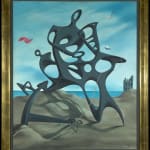Tristram Hillier
Object on a beach no.1, 1936
Oil on canvas
30 x 24 3/4 in, 76.1 x 63 cm
Signed and dated lower right 'Hillier 36'
Moore met the young Tristram Hillier through the Unit One group and they exhibited together at the group’s one and only exhibition at the Mayor Gallery in 1934. This was...
Moore met the young Tristram Hillier through the Unit One group and they exhibited together at the group’s one and only exhibition at the Mayor Gallery in 1934. This was a hugely influential period in both artist’s lives.
Hillier made several paintings of beach-scenes during the 1930s, many of them taking an anchor as his subject. In these works, and in particular 'Object on a beach no.1', the inanimate anchor is heavily anthropomorphised and depicted in a state of transfiguration in a Surreal parody of Classical metamorphosis. During the 1930s under the influence of Surrealism, Moore explored his unconscious mind, looking for chance associations that were found between his medium and the natural world, to create a more mysterious and unusual fusion of the human figure, the landscape and abstraction. In the present work we see Hillier developing a similar approach, finding the enigmatic in the everyday object of the anchor.
Much like Moore’s treatment of the human figure, Hillier takes his subject, in this case an Anchor, and transforms it. The Anchor becomes a dancing "figure" and he uses a rope to twist through the holes to emphasise the interior and exterior. Piercing was one of the major innovations of Moore’s practice, breaking through the solidity of sculpture to create a wholly modern image centred on form and mass. Hillier’s use of this imagery emphasises the magnitude of influence Moore had on his contemporaries in both sculpture and painting.
Hillier was also heavily influenced by the work of proto-Surrealist Giorgio de Chirico who he had seen in Paris in the 1920s. As with de Chirico, Hillier utilises an empty – almost tranquil - everyday setting and an unusual use of scale in the monumentality of the anchor to create an unsettling and mysterious image, that makes us rethink the world around us. These works are considered some of the most important paintings that Hillier made and demonstrate a unique voice in British modernism. Similar paintings 'Variation on the form of an anchor' 1939 and 'Marine' 1934 are now held in the Tate Collection and by Pallant House Gallery respectively.
Hillier made several paintings of beach-scenes during the 1930s, many of them taking an anchor as his subject. In these works, and in particular 'Object on a beach no.1', the inanimate anchor is heavily anthropomorphised and depicted in a state of transfiguration in a Surreal parody of Classical metamorphosis. During the 1930s under the influence of Surrealism, Moore explored his unconscious mind, looking for chance associations that were found between his medium and the natural world, to create a more mysterious and unusual fusion of the human figure, the landscape and abstraction. In the present work we see Hillier developing a similar approach, finding the enigmatic in the everyday object of the anchor.
Much like Moore’s treatment of the human figure, Hillier takes his subject, in this case an Anchor, and transforms it. The Anchor becomes a dancing "figure" and he uses a rope to twist through the holes to emphasise the interior and exterior. Piercing was one of the major innovations of Moore’s practice, breaking through the solidity of sculpture to create a wholly modern image centred on form and mass. Hillier’s use of this imagery emphasises the magnitude of influence Moore had on his contemporaries in both sculpture and painting.
Hillier was also heavily influenced by the work of proto-Surrealist Giorgio de Chirico who he had seen in Paris in the 1920s. As with de Chirico, Hillier utilises an empty – almost tranquil - everyday setting and an unusual use of scale in the monumentality of the anchor to create an unsettling and mysterious image, that makes us rethink the world around us. These works are considered some of the most important paintings that Hillier made and demonstrate a unique voice in British modernism. Similar paintings 'Variation on the form of an anchor' 1939 and 'Marine' 1934 are now held in the Tate Collection and by Pallant House Gallery respectively.
Provenance
The artistBen P. Hillier (gifted by the artist during the 1950s and thence by descent)
Exhibitions
Bradford, Cartwright Hall (June – July 1983); London, Royal Academy (August – September 1983); Kingston-Upon-Hull, Ferens Art Gallery (September – October 1983); Preston, Harris Museum and Art Gallery (November – December 1983), A Timeless Journey: Tristram Hillier, RA 1905-1983, no.12
London, Royal Academy, Tristram Hillier RA (1905-1983), 14 March – 25 June 2008



